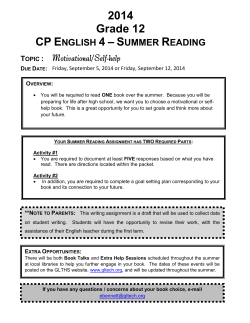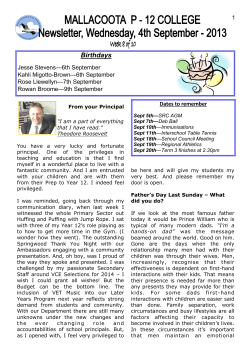
Suggestions for Children’s Books that Include Tracy Burt, Aimee Gelnaw, and Lee Klinger Lesser
Suggestions for Children’s Books that Include Lesbian, Gay, Bisexual, and Transgender (LGBT) Families Tracy Burt, Aimee Gelnaw, and Lee Klinger Lesser Reading children’s books that are inclusive of LGBT families is an essential strategy both for supporting the selfesteem of children from these families and for teaching all children about the diversity of families. Building the skills and readiness to include these books in your curriculum is a process. Here are some suggestions for responding to common questions and concerns. If a child asks, “Why doesn’t Tyrone have a mommy?” or “Why does Tyrone have two daddies?” a simple response might be, “Isn’t Tyrone lucky? He has two daddies who love him.” When we focus on the love and care from whoever is in the child’s family, we are focusing on what is most important. We can move from there to explore, in a fun and positive way, the many ways in which families are the same and different. If children ask questions you don’t know how to answer, you can say you are not sure, but you will find out and get back to them. Be sure to follow up with an answer that is age appropriate. Family survey books These books include many kinds of families, including LGBT families. All Families Are Special, by Norma Simon. Illus. by Teresa Flavin. 2003. Morton Grove: Albert Whitman and Company. A teacher talks about her own family while children in the class share stories of their families in this warm and simple book that affirms its title: All families are special. Everywhere Babies, by Susan Meyers. Illus. by Marla Frazee. 2001. San Diego: Harcourt Inc. A charming, award-winning board book for infant/toddlers, that features ® 2 If you are nervous about reading a story, think about the questions children are likely to ask. You can practice answering them and review your answers with an early childhood colleague. If the books are new to your center, it is important to be prepared for different responses from families and the community. Starting with a book that surveys all different kinds of families might be easier than starting with a book that focuses only on LGBT families. Children usually do not need much of an introduction or explanation; issues arise when adults challenge your choice to read a specific book. Listen to peoples’ concerns and create a space for dialogue, but be clear about your own commitment, and the commitment of the program, to diversity and to respect for all families. The NAEYC Code of Ethical Conduct (NAEYC 2005) provides a foundation early childhood educators can rely on when explaining the reason for reflecting diverse families throughout the curriculum. illustrations of babies and their parents—including LGBT parents—in loving and caring moments together. One Hundred Is a Family, by Pam Munoz Ryan. Illus. by Benrei Huang. 1994. New York: Hyperion Paperbacks for Children. Playful illustrations that include many different kinds of families fill this book that counts up to 100. Who’s in a Family? by Robert Skutch. Illus. by Laura Nienhaus. 1995 Berkeley: Tricycle Press. With fun illustrations, of people and animals, diversity of families is described in an engaging way for children. 1, 2, 7 Young Children • Online Handout • January 2010 Stories that happen to be about LGBT families The main characters in these stories come from LGBT families. And Tango Makes Three, by Justin Richardson and Peter Parnell. Illus. by Henry Cole. 2005. Simon & Schuster Children’s Publishing. Based on a true story of two male penguins at the Central Park Zoo who raised a baby penguin together, this is a heartwarming and fun story. Emma and Meesha My Boy, by Kaitlyn Considine. Illus. by Binny Hobbs. 2005. www.twomombooks.com. A very simple book in which Emma learns from her two moms how to be nice to her cat. It is easy and engaging for children with cartoonlike illustrations. Felicia’s Favorite Story, by Lesléa Newman. Illus. by Adriana Romo. 2002. Ridley Park, PA: Two Lives Publishing. In this simple book children learn about a loving family with two moms and an adopted daughter. They listen in on Felicia’s favorite bedtime story— how her family came to be. Daddy, Papa, and Me, by Leslea Newman. Illus. by Carol Thompson. 2009. Berkeley: Tricycle Press. A toddler and his two daddies spend the day together. Everyday activities are colorfully drawn and written about in rhyming text. Mama Eat Ant, Yuck! by Barbara Lynn Edmonds. Illus. by Matthew Daniele. Eugene, Oregon: Hundredth Munchy Publications. A playful, funny story about one mother in a two-mom household who eats some ant-covered raisins by mistake and inspires her youngest daughter to begin speaking: “Mama eat ant, yuck!” Young Children • Online Handout • January 2010 Uncle Bobby’s Wedding, by Sarah S. Brannen. 2008. G.P. Putnam’s and Sons. This tender story, using animals as the characters, focuses on Chloe, who is sad because her Uncle Bobby is marrying his partner; she is afraid that she will not be special to him anymore. She ends up discovering that she now has two uncles who love and cherish her Books that address issues concerning LGBT families These books raise and address some of the conflicts or issues that may arise in relation to LGBT families. Antonio’s Card/La Tarjeta de Antonio, by Rigoberto Gonzalez. Illus. By Cecilia Concepción Álvarez. 2005. (Bilingual English/Spanish). San Francisco: Children’s Book Press. In this book for children 5 or older, Antonio searches for a way to express his affection for his mother and her partner on Mother’s Day. Asha’s Mums, by Rosamund Elwind and Michele Paulse. Illus. by Dawn Lee. 1993. Toronto: Women’s Press. Asha has to face the bias and ignorance of her teacher, who doesn’t accept her family. Asha’s moms advocate for her, and all the children learn more about the diversity of families. Molly’s Family, by Nancy Garden. Illus. by Sharon Wooding. 2004. New York: Farrar Straus Giroux. While happily drawing a family picture for back-to-school night, Molly is confronted by a classmate who tells her that she can’t have a “mommy and a mama.” The teacher’s response and resolution are valuable role models. 3 One Dad, Two Dads, Brown Dad, Blue Dads, by Johnny Valentine. Illus. by Melody Sarecky. 1994. Los Angeles: Alyson Wonderland. In a whimsical and playful manner, a child learns about another child’s family composed of blue dads. Many of the questions asked about having blue dads are the same questions often asked about having two dads. Gender The main characters in these books come to a new understanding of gender stereotyping and gender identity in themselves and others. 10,000 Dresses, by Marcus Ewert. Illus. by Rex Ray. 2008. Seven Stories Press. A very well-written story about Bailey, who in her dreams is a young girl. Every night she dreams about magical dresses. Unfortunately, when Bailey wakes up, nobody wants to hear about her beautiful dreams because she is anatomically a boy, and her family and friends say she shouldn’t be thinking about dresses at all. However, Bailey meets an older girl who is touched and inspired by Bailey’s dreams and courage. Eventually 4 they start making dresses together that represent Bailey’s dreams coming to life. Carly: She’s Still My Daddy, by Mary Boenke. Illus. by Dolores Dudley. 2004. PFLAG/TNET. (Available from Two Lives Publishing.) This booklet, written from a child’s point of view, is about a father’s transition from Carl to Carly. This is the only early elementary text for children that we have found on a transgender family. Pugdog, by Andrea U’Ren. 2001. Farrar, Straus & Giroux. Gender biases and assumptions are explored in this fun book about the mistaken gender identity of a dog. This is a lively, engaging way to open up the topic of gender biases and roles with children. Resources NAEYC. 2005. Position statement. NAEYC code of ethical conduct and statement of commitment. Rev. ed. Brochure. Washington, DC: Author. www.naeyc.org/positionstatements/ethical_conduct Copyright © 2010 by the National Association for the Education of Young Children. See Permissions and Reprints online at www.naeyc.org/yc/permissions. Young Children • Online Handout • January 2010
© Copyright 2025





















